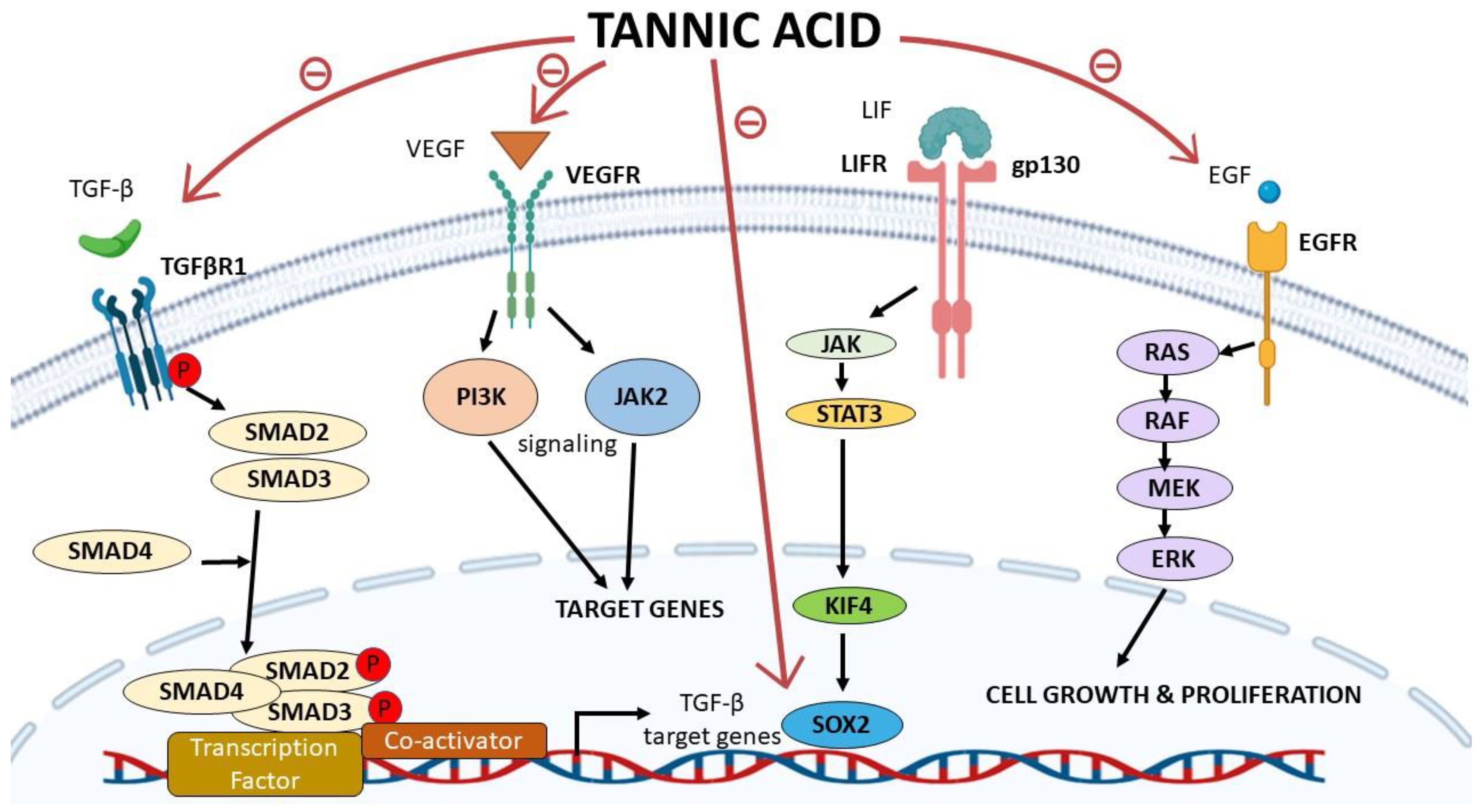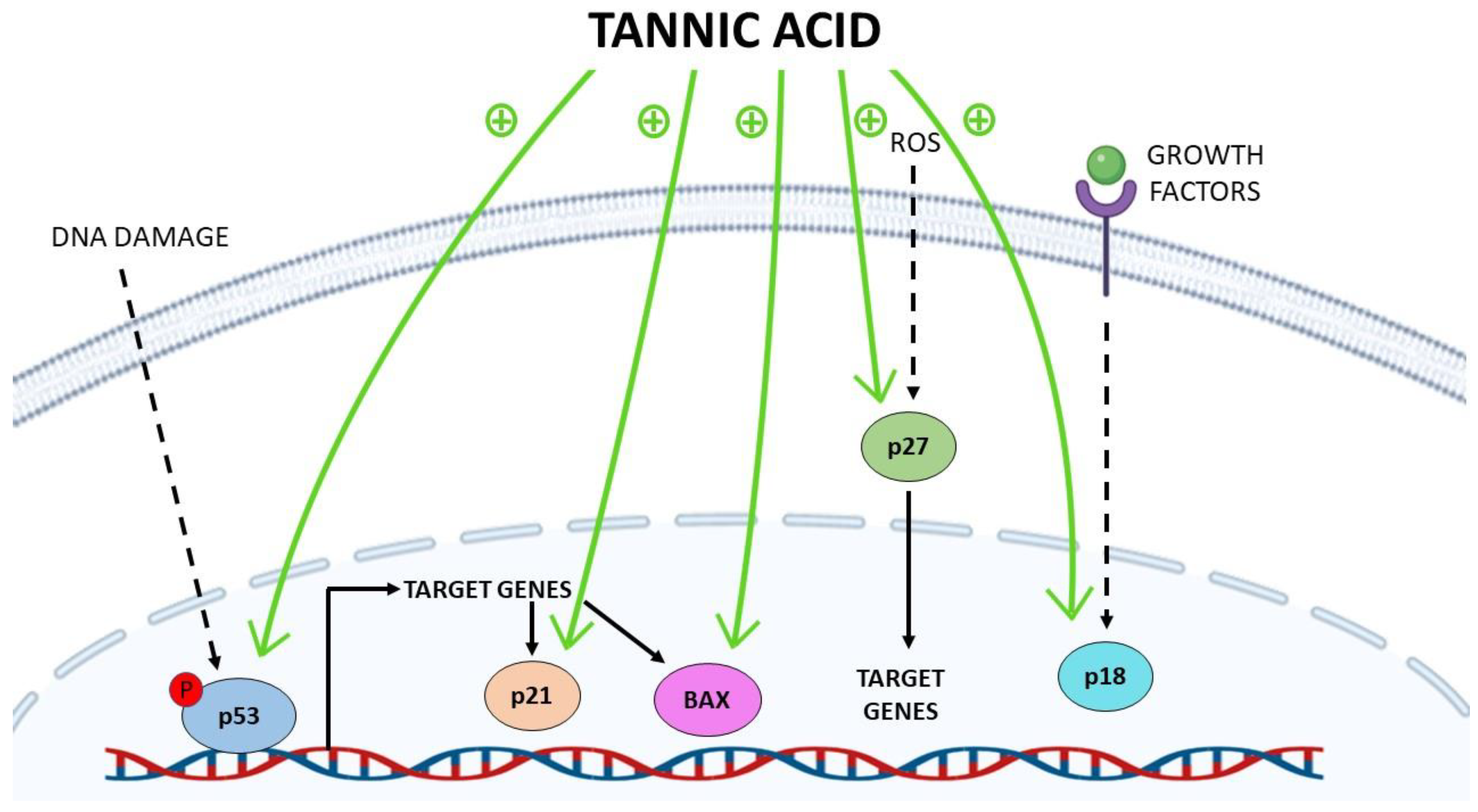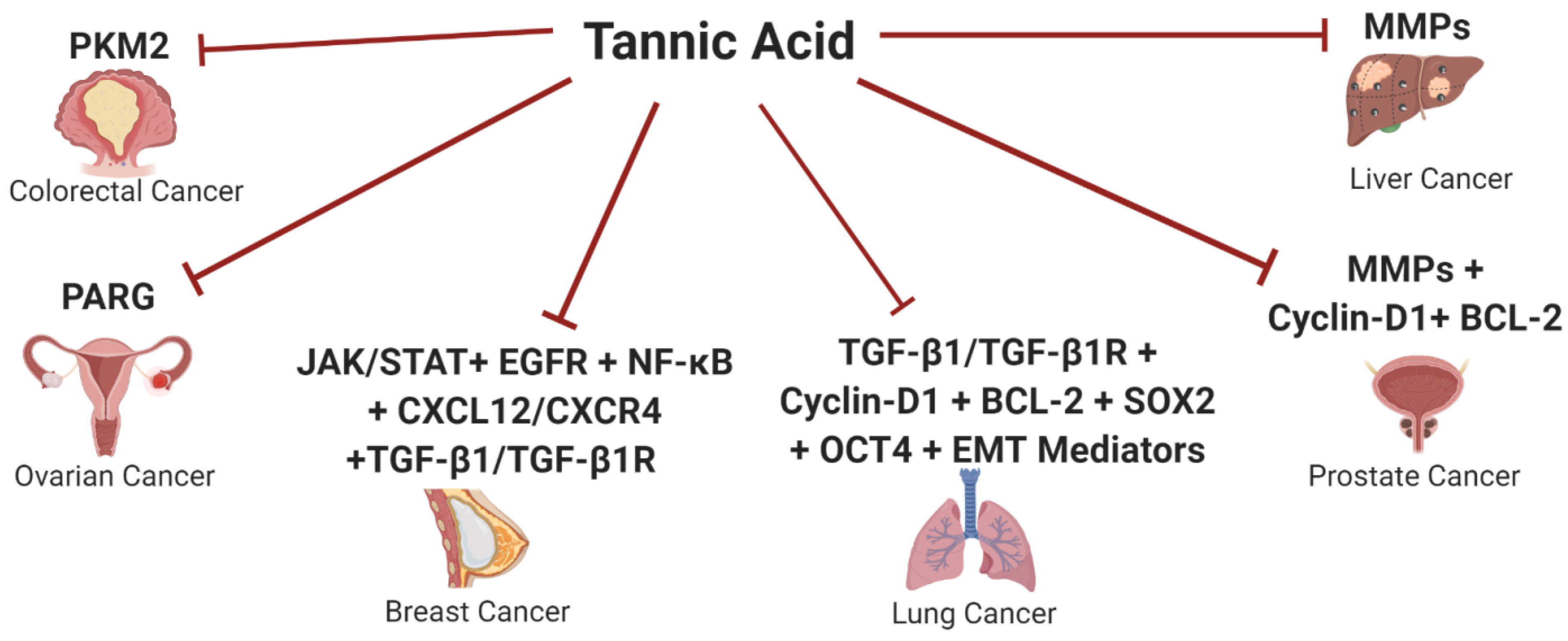Recent Advances in Tannic Acid (Gallotannin) Anticancer Activities and Drug Delivery Systems for Efficacy Improvement; A Comprehensive Review
Abstract
1. Introduction
2. TA in Lung Cancer
3. TA in Breast Cancer
4. TA in Colorectal Cancer
5. TA in Liver Cancer
6. TA in Ovarian Cancer
7. TA in Pancreatic Cancer
8. TA in Prostate Cancer
9. TA in Gingival Cancer
10. TA-Based Pharmaceutical Formulations
11. Combinational Approach of TA with Conventional Chemotherapeutic Agents in Pharmaceutical Formulations
12. Conclusions
Author Contributions
Funding
Institutional Review Board Statement
Informed Consent Statement
Data Availability Statement
Conflicts of Interest
Sample Availability
References
- ElKhouly, A.M.; Youness, R.A.; Gad, M.Z. MicroRNA-486-5p and microRNA-486-3p: Multifaceted pleiotropic mediators in oncological and non-oncological conditions. Noncoding RNA Res. 2020, 5, 11–21. [Google Scholar] [CrossRef] [PubMed]
- Baer-Dubowska, W. Tannic Acid: Specific Form of Tannins in Cancer Chemoprevention and Therapy-Old and New Applications. Curr. Pharmacol. Rep. 2020, 6, 28–37. [Google Scholar] [CrossRef]
- Youness, R.A.; Gad, M.Z. Long non-coding RNAs: Functional regulatory players in breast cancer. Noncoding RNA Res. 2019, 4, 36–44. [Google Scholar] [CrossRef]
- Ahmed Youness, R. A methoxylated quercetin glycoside harnesses HCC tumor progression in a TP53/miR-15/miR-16 dependent manner. Nat. Prod. Res. 2020, 34, 1475–1480. [Google Scholar] [CrossRef] [PubMed]
- Shaalan, Y.M. Destabilizing the interplay between miR-1275 and IGF2BPs by Tamarix articulata and quercetin in hepatocellular carcinoma. Nat. Prod. Res. 2018, 32, 2217–2220. [Google Scholar] [CrossRef]
- Elkhouly, A. miR-486-5p and miR-17-5p: Novel Immunomodulatory Non-coding RNAs Drawn Downstream 3′-O-Acetylvitexin in Triple Negative Breast Cancer. Eur. J. Cancer 2020, 138, S70. [Google Scholar] [CrossRef]
- Awad, A.R. An acetylated derivative of vitexin halts MDA-MB-231 cellular progression and improves its immunogenic profile through tuning miR- 20a-MICA/B axis. Nat. Prod. Res. 2019, 1–5. [Google Scholar] [CrossRef]
- Youness, R. PO-352 Hijacking hepatocellular carcinoma (HCC) tumour progression through restoring TP53/miR-15a/miR-16 tumour suppressor axis by a novel quercetin glycoside. ESMO Open 2018, 3, A160. [Google Scholar] [CrossRef]
- Kuo, M.-L.; Lee, K.-C.; Lin, J.-K. Genotoxicities of nitropyrenes and their modulation by apigenin, tannic acid, ellagic acid and indole-3-carbinol in the Salmonella and CHO systems. Mutat. Res. Fundam. Mol. Mech. Mutagenes. 1992, 270, 87–95. [Google Scholar] [CrossRef]
- Ashafaq, M.; Tabassum, H.; Parvez, S. Modulation of behavioral deficits and neurodegeneration by tannic acid in experimental stroke challenged Wistar rats. Mol. Neurobiol. 2017, 54, 5941–5951. [Google Scholar] [CrossRef]
- Wu, S. Development of a safe and efficient gene delivery system based on a biodegradable tannic acid backbone. Colloids Surf. B Biointerfaces 2019, 183, 110408. [Google Scholar] [CrossRef]
- Pinakin, D.J. Nutraceutical potential of tree flowers: A comprehensive review on biochemical profile, health benefits, and utilization. Food Res. Int. 2020, 127, 108724. [Google Scholar] [CrossRef] [PubMed]
- Jo, H.J. Radical Scavenging Activities of Tannin Extracted from Amaranth (Amaranthus caudatus L.). J. Microbiol. Biotechnol. 2015, 25, 795–802. [Google Scholar] [CrossRef] [PubMed]
- Perumal, P.O. Cytoproliferative and Anti-Oxidant Effects Induced by Tannic Acid in Human Embryonic Kidney (Hek-293) Cells. Biomolecules 2019, 9, 767. [Google Scholar] [CrossRef]
- Yeo, J. Tannic acid-based nanogel as an efficient anti-inflammatory agent. Biomater. Sci. 2020, 8, 1148–1159. [Google Scholar] [CrossRef]
- Pattarayan, D. Tannic acid attenuates TGF-beta1-induced epithelial-to-mesenchymal transition by effectively intervening TGF-beta signaling in lung epithelial cells. J. Cell. Physiol. 2018, 233, 2513–2525. [Google Scholar] [CrossRef] [PubMed]
- Kim, D.A. Tannic acid attenuates the formation of cancer stem cells by inhibiting NF-kappaB-mediated phenotype transition of breast cancer cells. Am. J. Cancer Res. 2019, 9, 1664–1681. [Google Scholar]
- Hatami, E. Abstract 1871: Tannic acid: A natural anticancer agent for non-small cell lung cancer. Cancer Res. 2019, 79, 1871. [Google Scholar]
- Nagesh, P.K.B. Tannic Acid Induces Endoplasmic Reticulum Stress-Mediated Apoptosis in Prostate Cancer. Cancers 2018, 10, 68. [Google Scholar] [CrossRef]
- Darvin, P. Tannic acid inhibits the Jak2/STAT3 pathway and induces G1/S arrest and mitochondrial apoptosis in YD-38 gingival cancer cells. Int. J. Oncol. 2015, 47, 1111–1120. [Google Scholar] [CrossRef] [PubMed]
- Sp, N. Tannic Acid Inhibits Non-small Cell Lung Cancer (NSCLC) Stemness by Inducing G0/G1 Cell Cycle Arrest and Intrinsic Apoptosis. Anticancer Res. 2020, 40, 3209–3220. [Google Scholar] [CrossRef]
- Nie, F. Apoptotic effect of tannic acid on fatty acid synthase over-expressed human breast cancer cells. Tumor Biol. 2016, 37, 2137–2143. [Google Scholar] [CrossRef] [PubMed]
- Darvin, P. Tannic acid inhibits EGFR/STAT1/3 and enhances p38/STAT1 signalling axis in breast cancer cells. J. Cell. Mol. Med. 2017, 21, 720–734. [Google Scholar] [CrossRef]
- Chen, X. Tannic Acid Is an Inhibitor of CXCL12 (SDF-1α)/CXCR4 with Antiangiogenic Activity. Clin. Cancer Res. 2003, 9, 3115–3123. [Google Scholar]
- Yang, P. Tannic acid directly targets pyruvate kinase isoenzyme M2 to attenuate colon cancer cell proliferation. Food Funct. 2018, 9, 5547–5559. [Google Scholar] [CrossRef] [PubMed]
- Chu, X. Ameliorative effects of tannic acid on carbon tetrachloride-induced liver fibrosis in vivo and in vitro. J. Pharmacol. Sci. 2016, 130, 15–23. [Google Scholar] [CrossRef]
- Sun, Y. Tannic acid, an inhibitor of poly(ADP-ribose) glycohydrolase, sensitizes ovarian carcinoma cells to cisplatin. Anticancer Drugs 2012, 23, 979–990. [Google Scholar] [CrossRef]
- Mhlanga, P. Mechanistic Insights into Oxidative Stress and Apoptosis Mediated by Tannic Acid in Human Liver Hepatocellular Carcinoma Cells. Int. J. Mol. Sci. 2019, 20, 6145. [Google Scholar] [CrossRef] [PubMed]
- Cosan, D. The effects of resveratrol and tannic acid on apoptosis in colon adenocarcinoma cell line. Saudi Med. J. 2009, 30, 191–195. [Google Scholar] [PubMed]
- Bray, F. Global cancer statistics 2018: GLOBOCAN estimates of incidence and mortality worldwide for 36 cancers in 185 countries. CA Cancer J. Clin. 2018, 68, 394–424. [Google Scholar] [CrossRef] [PubMed]
- Youness, R.A. A novel role of sONE/NOS3/NO signaling cascade in mediating hydrogen sulphide bilateral effects on triple negative breast cancer progression. Nitric Oxide 2018, 80, 12–23. [Google Scholar] [CrossRef]
- Youness, R.A. The long noncoding RNA sONE represses triple-negative breast cancer aggressiveness through inducing the expression of miR-34a, miR-15a, miR-16, and let-7a. J. Cell. Physiol. 2019, 234, 20286–20297. [Google Scholar] [CrossRef]
- Ngobili, T.A. Remodeling of tannic acid crosslinked collagen type I induces apoptosis in ER+ breast cancer cells. Anticancer Res. 2015, 35, 1285–1290. [Google Scholar]
- Jordan, L.G.; Booth, B.W. HER2(+) breast cancer cells undergo apoptosis upon exposure to tannic acid released from remodeled cross-linked collagen type I. J. Biomed. Mater. Res. A 2018, 106, 26–32. [Google Scholar] [CrossRef]
- Tikoo, K.; Sane, M.S.; Gupta, C. Tannic acid ameliorates doxorubicin-induced cardiotoxicity and potentiates its anti-cancer activity: Potential role of tannins in cancer chemotherapy. Toxicol. Appl. Pharmacol. 2011, 251, 191–200. [Google Scholar] [CrossRef] [PubMed]
- Chowdhury, P. Tannic acid-inspired paclitaxel nanoparticles for enhanced anticancer effects in breast cancer cells. J. Colloid Interface Sci. 2019, 535, 133–148. [Google Scholar] [CrossRef] [PubMed]
- Geng, N. Tannic acid synergistically enhances the anticancer efficacy of cisplatin on liver cancer cells through mitochondriamediated apoptosis. Oncol. Rep. 2019, 42, 2108–2116. [Google Scholar] [PubMed]
- Pokhriyal, R. Chemotherapy Resistance in Advanced Ovarian Cancer Patients. Biomark. Cancer 2019, 11, 1179299X19860815. [Google Scholar] [CrossRef] [PubMed]
- Rawla, P.; Sunkara, T.; Gaduputi, V. Epidemiology of Pancreatic Cancer: Global Trends, Etiology and Risk Factors. World J. Oncol. 2019, 10, 10–27. [Google Scholar] [CrossRef]
- Chauhan, S.S. Pectin-Tannic Acid Nano-Complexes Promote the Delivery and Bioactivity of Drugs in Pancreatic Cancer Cells. Pharmaceutics 2020, 12, 285. [Google Scholar] [CrossRef]
- Karakurt, S.; Adali, O. Tannic Acid Inhibits Proliferation, Migration, Invasion of Prostate Cancer and Modulates Drug Metabolizing and Antioxidant Enzymes. Anticancer Agents Med. Chem. 2016, 16, 781–789. [Google Scholar] [CrossRef] [PubMed]
- Nagesh, P.K.B. Tannic acid inhibits lipid metabolism and induce ROS in prostate cancer cells. Sci. Rep. 2020, 10, 980. [Google Scholar] [CrossRef]
- Duan, Q. Clinical significance of cytokeratin in the cervical lymph nodes of patients with mandibular gingival squamous cell carcinoma. Oncol. Lett. 2018, 16, 3135–3139. [Google Scholar] [CrossRef] [PubMed]
- Sahiner, N.; Sagbas, S.; Aktas, N. Single step natural poly (tannic acid) particle preparation as multitalented biomaterial. Mater. Sci. Eng. C 2015, 49, 824–834. [Google Scholar] [CrossRef] [PubMed]
- Baldwin, A. The in vivo biocompatibility of novel tannic acid-collagen type I injectable bead scaffold material for breast reconstruction post-lumpectomy. J. Biomater. Appl. 2020, 34, 1315–1329. [Google Scholar] [CrossRef] [PubMed]
- Cass, C.A.; Burg, K.J. Tannic acid cross-linked collagen scaffolds and their anti-cancer potential in a tissue engineered breast implant. J. Biomater. Sci. Polym. Ed. 2012, 23, 281–298. [Google Scholar] [CrossRef] [PubMed]
- Kaczmarek, B. Normal and cancer cells response on the thin films based on chitosan and tannic acid. Toxicol. In vitro 2020, 62, 104688. [Google Scholar] [CrossRef]
- Bridgeman, C.J.; Nguyen, T.-U.; Kishore, V. Anticancer efficacy of tannic acid is dependent on the stiffness of the underlying matrix. J. Biomater. Sci. Polym. Ed. 2018, 29, 412–427. [Google Scholar] [CrossRef]
- Ren, Y. Improved anti-colorectal carcinomatosis effect of tannic acid co-loaded with oxaliplatin in nanoparticles encapsulated in thermosensitive hydrogel. Eur. J. Pharm. Sci. 2019, 128, 279–289. [Google Scholar] [CrossRef]
- Hatami, E. Tannic acid-lung fluid assemblies promote interaction and delivery of drugs to lung cancer cells. Pharmaceutics 2018, 10, 111. [Google Scholar] [CrossRef]
- Liu, L. Polymeric nanoparticles of poly (2-oxazoline), tannic acid and doxorubicin for controlled release and cancer treatment. Chin. Chem. Lett. 2020, 31, 501–504. [Google Scholar] [CrossRef]
- Huang, Y. Coordination driven self-assembly for enhancing the biological stability of nobiletin. J. Mol. Liq. 2019, 292, 111420. [Google Scholar] [CrossRef]
- Huang, H. pH-Responsive nanodrug encapsulated by tannic acid complex for controlled drug delivery. RSC Adv. 2017, 7, 2829–2835. [Google Scholar] [CrossRef]
- Elahi, N.; Kamali, M.; Baghersad, M.H. Recent biomedical applications of gold nanoparticles: A review. Talanta 2018, 184, 537–556. [Google Scholar] [CrossRef]
- Singh, P. Gold nanoparticles in diagnostics and therapeutics for human cancer. Int. J. Mol. Sci. 2018, 19, 1979. [Google Scholar] [CrossRef]
- Nag, S.; Manna, K.; Saha, K.D. Tannic acid-stabilized gold nano-particles are superior to native tannic acid in inducing ROS-dependent mitochondrial apoptosis in colorectal carcinoma cells via the p53/AKT axis. RSC Adv. 2019, 9, 8025–8038. [Google Scholar] [CrossRef]
- Saowalak, K. Iron (III)-tannic molecular nanoparticles enhance autophagy effect and T 1 MRI contrast in liver cell lines. Sci. Rep. 2018, 8, 1–13. [Google Scholar] [CrossRef] [PubMed]
- Kitagawa, S. Inhibition of P-glycoprotein function by tannic acid and pentagalloylglucose. J. Pharm. Pharmacol. 2007, 59, 965–969. [Google Scholar] [CrossRef]
- Glinsky, V.V.; Raz, A. Modified citrus pectin anti-metastatic properties: One bullet, multiple targets. Carbohydr. Res. 2009, 344, 1788–1791. [Google Scholar] [CrossRef] [PubMed]
- Sanyakamdhorn, S.; Agudelo, D.; Tajmir-Riahi, H.-A. Encapsulation of antitumor drug doxorubicin and its analogue by chitosan nanoparticles. Biomacromolecules 2013, 14, 557–563. [Google Scholar] [CrossRef] [PubMed]
- Naidu, P.S. Novel Hydrophilic Copolymer-Based Nanoparticle Enhances the Therapeutic Efficiency of Doxorubicin in Cultured MCF-7 Cells. ACS Omega 2019, 4, 17083–17089. [Google Scholar] [CrossRef] [PubMed]
- Lucas, A.; Lam, D.; Cabrales, P. Doxorubicin-loaded red blood cells reduced cardiac toxicity and preserved anticancer activity. Drug Deliv. 2019, 26, 433–442. [Google Scholar] [CrossRef] [PubMed]
- Takemoto, Y.; Ajiro, H.; Akashi, M. Hydrogen-bonded multilayer films based on poly (N-vinylamide) derivatives and tannic acid. Langmuir 2015, 31, 6863–6869. [Google Scholar] [CrossRef] [PubMed]
- Hu, X. Hybrid polymer micelles capable of cRGD targeting and pH-triggered surface charge conversion for tumor selective accumulation and promoted uptake. Chem. Commun. 2014, 50, 9188–9191. [Google Scholar] [CrossRef]
- Bai, J.; Liu, Y.; Jiang, X. Multifunctional PEG-GO/CuS nanocomposites for near-infrared chemo-photothermal therapy. Biomaterials 2014, 35, 5805–5813. [Google Scholar] [CrossRef]
- Le, Z. Hydrogen-bonded tannic acid-based anticancer nanoparticle for enhancement of oral chemotherapy. ACS Appl. Mater. Interfaces 2018, 10, 42186–42197. [Google Scholar] [CrossRef]
- Tian, J.; Stella, V.J. Degradation of paclitaxel and related compounds in aqueous solutions III: Degradation under acidic pH conditions and overall kinetics. J. Pharm. Sci. 2010, 99, 1288–1298. [Google Scholar] [CrossRef]
- Hatami, E. Development of Zoledronic Acid-Based Nanoassemblies for Bone-Targeted Anticancer Therapy. ACS Biomater. Sci. Eng. 2019, 5, 2343–2354. [Google Scholar] [CrossRef]
- Yan, Y. Engineering particles for therapeutic delivery: Prospects and challenges. ACS Nano 2012, 6, 3663–3669. [Google Scholar] [CrossRef]
- Donadu, M. Phytochemical Compositions and Biological Activities of Essential Oils from the Leaves, Rhizomes and Whole Plant of HornstedtiabellaŠkorničk. Antibiotics 2020, 9, 334. [Google Scholar] [CrossRef] [PubMed]
- Lu, R. Medical Applications Based on Supramolecular Self-Assembled Materials from Tannic Acid. Front. Chem. 2020, 8, 583484. [Google Scholar] [CrossRef] [PubMed]
- Zhang, A. Phytochemistry and pharmacology of genus Ephedra. Chin. J. Nat. Med. 2018, 811–828. [Google Scholar] [CrossRef]
- Xiong, H. Transforming Complexity to Simplicity: Protein-Like Nanotransformer for Improving Tumor Drug Delivery Programmatically. Nano Lett. 2020, 20, 1781–1790. [Google Scholar] [CrossRef]
- Glunde, K. Extracellular acidification alters lysosomal trafficking in human breast cancer cells. Neoplasia 2003, 5, 533–545. [Google Scholar] [CrossRef]
- Guicciardi, M.E.; Leist, M.; Gores, G.J. Lysosomes in cell death. Oncogene 2004, 23, 2881–2890. [Google Scholar] [CrossRef] [PubMed]




| Effect | Molecular Target | Cancer Type | References |
|---|---|---|---|
| Inhibition | TGF-β1/TGF-β1R axis | Lung Cancer and Breast Cancer | [16,17] |
| EMT Mediators | Lung Cancer | [16] | |
| VEGF/VEGFR axis | Lung Cancer | [18] | |
| Cyclin D1 | Lung Cancer, Prostate Cancer, Gingival Cancer | [18,19,20] | |
| BCL-2 | Lung Cancer, Prostate Cancer | [18,19] | |
| SOX2 | Lung Cancer | [21] | |
| OCT4 | Lung Cancer | [21] | |
| NANOG | Lung Cancer | [21] | |
| Fatty acid synthase | Breast Cancer | [22] | |
| JAK/STAT signaling pathway | Gingival Cancer, Breast Cancer, | [20,23] | |
| epidermal growth factor receptor (EGFR) | Breast Cancer | [23] | |
| NF-Κb | Breast Cancer | [17] | |
| CXCL12/CXCR4 | Breast Cancer | [24] | |
| pyruvate kinase isoenzyme M2 (PKM2) | Colorectal Cancer | [25] | |
| MMPs | Prostate Cancer, Liver Cancer, | [19,26] | |
| poly(ADP-ribose) glycohydrolase (PARG) | Ovarian Cancer | [27] | |
| Induction | p53 | Lung Cancer, Gingival Cancer | [18,20] |
| p21 | Lung Cancer, Prostate Cancer, Gingival Cancer | [18,19,20] | |
| P27 | Gingival Cancer | [20] | |
| p18 | Lung Cancer, Prostate Cancer | [18,19] | |
| BAX | Lung Cancer, Prostate Cancer | [18,19] | |
| Caspases | Prostate Cancer, Breast Cancer, Liver Cancer, Ovarian Cancer | [19,22,28], [27] | |
| Bak and FADD ratio | Colorectal Cancer | [29] | |
| ER stress response (Protein kinase R-like endoplasmic reticulum kinase (PERK) and inositol requiring enzyme 1 (IRE1) | Prostate Cancer | [19] |
| Drug | Dosage Form | Cell Line | Most Important Key Finding | References |
|---|---|---|---|---|
| Oxaliplatin | Polymeric nanoparticle | CT26 | Synergistic inhibitory effect of oxaliplatin and TA | [49] |
| Paclitaxel | Nanoparticle | MDA-MB-231 | Reduced IC50 & increased cellular uptake of the drug compared to free drug | [36] |
| Gemcitabine, 5-Flurouracil &irinotecan | Nanocomplex | HPAF-II and PANC-1 | Lower IC50 value& increased cellular uptake for the drugs | [40] |
| Gemcitabine, carboplatin &irinotecan | Nanocomplex | A549 and H1299 | Enhanced decrease in IC50 from drug-loaded nanocomplex fabricated from TA and mice lung fluid | [50] |
| Doxorubicin hydrochloride | Polymeric nanoparticle | HeLa | Similar inhibitory action of the nanoparticles compared to the free drug at the same concentration of 5 mg/mL | [51] |
| Nobelitin | Coated nanoparticle | H1299 | Improved anticancer effect as well as good cytocompatibility at nobelitin concentration of 80 µg/ mL | [52] |
| Paclitaxel | Nanocomplex | A549 | Lower IC50 values compared to both the pure drug and uncoated nanoparticles | [53] |
Publisher’s Note: MDPI stays neutral with regard to jurisdictional claims in published maps and institutional affiliations. |
© 2021 by the authors. Licensee MDPI, Basel, Switzerland. This article is an open access article distributed under the terms and conditions of the Creative Commons Attribution (CC BY) license (http://creativecommons.org/licenses/by/4.0/).
Share and Cite
A. Youness, R.; Kamel, R.; A. Elkasabgy, N.; Shao, P.; A. Farag, M. Recent Advances in Tannic Acid (Gallotannin) Anticancer Activities and Drug Delivery Systems for Efficacy Improvement; A Comprehensive Review. Molecules 2021, 26, 1486. https://doi.org/10.3390/molecules26051486
A. Youness R, Kamel R, A. Elkasabgy N, Shao P, A. Farag M. Recent Advances in Tannic Acid (Gallotannin) Anticancer Activities and Drug Delivery Systems for Efficacy Improvement; A Comprehensive Review. Molecules. 2021; 26(5):1486. https://doi.org/10.3390/molecules26051486
Chicago/Turabian StyleA. Youness, Rana, Rabab Kamel, Nermeen A. Elkasabgy, Ping Shao, and Mohamed A. Farag. 2021. "Recent Advances in Tannic Acid (Gallotannin) Anticancer Activities and Drug Delivery Systems for Efficacy Improvement; A Comprehensive Review" Molecules 26, no. 5: 1486. https://doi.org/10.3390/molecules26051486
APA StyleA. Youness, R., Kamel, R., A. Elkasabgy, N., Shao, P., & A. Farag, M. (2021). Recent Advances in Tannic Acid (Gallotannin) Anticancer Activities and Drug Delivery Systems for Efficacy Improvement; A Comprehensive Review. Molecules, 26(5), 1486. https://doi.org/10.3390/molecules26051486










